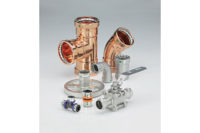
Most of the U.S. public is well-educated on the effects of lead in the human body - particularly its effects on young children. With the ongoing Washington, D.C. lead saga continually in our nation's news, it is only appropriate to discuss solutions to lead in drinking water. But first, let's talk about how it gets there.
Background
Lead in drinking water is rarely of significant quantity unless introduced as a result of man's activities, since it tends to complex or precipitate with a large number of substances. Typically, source waters have less lead in them than water reaching the user. This is because, in general, lead is introduced into water via the corrosion of plumbing materials containing lead (lead pipes, certain brass components, lead-based solder joints, etc.) and, while an excellent job has been done in reducing these sources in water systems, these components still exist today - particularly in older municipalities. Lead can also be in particulate form in water.Higher temperature, low-pH, and dwell time of water in contact with these components are among the factors that tend to increase the lead concentration in water seen at the tap. Strategies which may be employed by municipalities in dealing with lead in their distribution systems include chemical addition, or intentionally coating pipes with a precipitate or film layer, which acts as a barrier between water and the offending lead source - thus significantly reducing corrosion rates. Once introduced, these strategies can prove very effective at keeping lead corrosion to a minimum.
To make a long story short, the Washington, D.C. lead problems are most likely a result of a change in water chemistry - one that could take place in a number of other cities throughout the United States as well. (In some cases it may already be occurring.) The Washington, D.C. situation may also be a case of a utility's best intentions with respect to one water quality parameter, negatively affecting another.
In an effort to reduce the levels of disinfection byproducts (DBPs) that can accompany chlorine disinfection in certain scenarios, the D.C. Water and Sewer Authority (WASA) switched to chloramine disinfection in November 2000 for secondary disinfection (distribution system protection against pathogens). The switch was a result of the fact that DBPs are regulated to very low levels in drinking water due to suspected carcinogenic effects. Prior to the switch, D.C . water was disinfected using free-chlorine (elemental chlorine), which reacts to form a lead oxide that can coat surfaces. For a long time, such an oxide coating may have been responsible for reduced leaching rates, and binding of lead, in the water system.
Chloramination, which involves the use of ammonia in the disinfection process, lowers the redox potential in the water and also increases the level of nitrification (bacterial action) in water, which can lower pH. Lower redox potential allows precipitated lead (Pb+4) to chemically reduce to (Pb+2), which is re-dissolved into the water. Lower-pH conditions are more corrosive to plumbing or piping components, including those made from or containing lead, as well as protective films inside plumbing components.
Testing For Lead
If lead is suspected in water, testing should be carried out through a state-certified laboratory and water samples should be drawn per the instructions given by that lab. Lead sampling protocol differs from many other contaminant sampling routines in that it seeks to obtain a “first draw” sample representative of water that has been motionless while in contact with plumbing and plumbing components for at least six hours. This is intended to represent cold-water corrosion occurring for a typical overnight period. (Again, longer dwell time and warmer water will see increased lead levels).Removing Lead
No lead abatement technique is as simple and efficient at removing lead from water as the technologies available for treatment at the tap: the point-of-use (POU) technologies. Many manufacturers of these technologies have products that are proven, via industry standards, to reduce lead levels well below the EPA's lead action level of 15 parts per billion (ppb) and effectively treat the water for consumption.POU technologies, such as reverse osmosis, adsorptive carbon block filters, or faucet-mounted filters combining fine-particle filtration capabilities and adsorptive media, are mainstays in lead reduction. In fact, thousands of these devices were donated by POU manufacturers and are yet being distributed by WASA in Washington, D.C. for temporary lead relief.
Filtering products for lead should be tested and certified to ANSI/NSF Standard 53, while reverse osmosis units should be tested to ANSI/NSF Standard 58. Both standards challenge equipment with an influent lead level of 150 ppb, requiring removals to, or below, 10 ppb. Standard 53 challenges products at pHs above and below neutral to check for release of trapped lead, while reverse osmosis is an effective barrier to lead throughout the drinking water pH spectrum. Such certified products are readily available and provide good protection when used per manufacturers' recommendations. Always pay particular attention to periodic change-out requirements for filters or cartridges.




